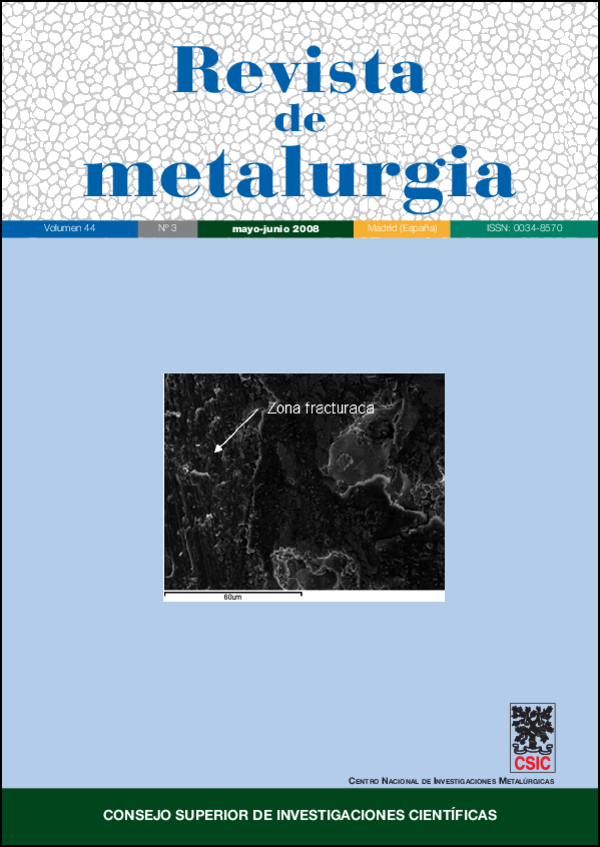X-ray diffraction line profile analysis of Cu –2 wt. % Cr –6 wt. % Mo alloy mechanically alloyed
DOI:
https://doi.org/10.3989/revmetalm.2008.v44.i3.112Keywords:
Mechanical alloying, XRD, Crystallite size, Stacking fault, Cu-Cr-MoAbstract
By X-ray diffraction line profile analysis it is possible to obtain valid information of structure and properties of materials. This method is a powerful tool for nanomaterials microstructure characterization. In the present work mechanical alloying of ternary system Cu -2 wt. % Cr -6 wt. % Mo was made between 0.25 and 4 h of milling. By means of modified Warren-Averbach and Williamson-Hall methods the crystallite size, dislocation density, microstrain and average distance between dislocations were estimated. The crystallite size values were corrected by stacking fault presence. It was demonstrated that powders have a high anisotropic strain, which was corrected using the average dislocation contrast factors for fcc structures. Also the influence of milling time and percentage of solute on stacking fault probability and stacking fault energy was determined.
Downloads
References
[1] E. MA, Prog. Mater. Sci. 50 (2005) 413-509. doi:10.1016/j.pmatsci.2004.07.001
[2] C. Suryanarayana, Mechanical Alloying and Mill, Marcell Dekker, Primera edición, New York, USA, 2004, pp. 83-94.
[3] E. Gaffet, C. Louison, M. Harmelin y F. Faudet, Mater. Sci. Eng. A 134 (1991) 1.380- 1.384.
[4] Y. Ogino, S. Murayama y T. Yamasaki, J. Less Common Metals 168 (1991) 221-235. doi:10.1016/0022-5088(91)90304-M
[5] M. Barro, E. Navarro, P. Agudo, A. Hernando, P. Crespo y A. García-Escorial, Mater. Sci. Forum 235:238 (1997) 553-558.
[6] Y. Wang, M. Chen, F. Zhou y E. Ma, Nature 419 (2002) 912-915. doi:10.1038/nature01133 PMid:12410306
[7] C. Suryanarayana, G.E. Korth y F.H. Froes, Metall. Mater. Trans. A 28 (1997) 293- 302. doi:10.1007/s11661-997-0132-4
[8] J. García-Barriocanal, G. Garcés, P. Pérez y P. Adeva, Rev. Metal. Madrid 41 (2005) 281-290.
[9] T. Chen, J.M. Hampikian y N.N. Thadhani, Acta Mater. 47 (1999) 2.567-2.579.
[10] J. Gubicza, M. Kassem, G. Ribárik y T. Ungár, Mater. Sci. Eng. A 372 (2004) 115-122. doi:10.1016/j.msea.2003.12.016
[11] E. Schafler, G. Steiner, E. Korznikova, M. Kerber y M.J. Zehetbauer, Mater. Sci. Eng. A 410/411 (2005) 169-173. doi:10.1016/j.msea.2005.08.070
[12] F.H. Froes, C. Suryanarayana, K.C. Rissell y C.M. Ward-Close. Novel Techniques in Synthesis and Processing of Advanced Materials, proceeding of a Symposium. Illinois, 1994. The Minerals, Metals & Materials Society (TMS) and the Materials Information Society (ASM Internacional).
[13] T. Ungár. Scr. Mater. 51 (2004) 777-781. doi:10.1016/j.scriptamat.2004.05.007
[14] T. Ungár, J. Gubicza, G. Ribárik y A. Borbély, J. Appl. Crys. 34 (2001) 298-310. doi:10.1107/S0021889801003715
[15] I. Groma, Phys. Rev. B 57 (1998) 7.535-7.542.
[16] E.J. Mittemeijer y P. Scardi, Diffraction Analysis of the Microstructure of Materials Spinger Verlag Berlin Heidelberg, New York, EE.UU., 2004, pp. 249-285.
[17] T. Ungár y G. Tichy, Phys. Status Solidi A 171 (1999) 425-434. doi:10.1002/(SICI)1521-396X(199902)171:2<425::AID-PSSA425>3.0.CO;2-W
[18] C. Aguilar, S. Ordoñez, J. Marin, F. Castro y V. Martínez. Mater. Sci. Eng. A en prensa.
[19] B.E. Warren. X-Ray Diffraction, Dover Publications Inc., New York, EE. UU., 1990, pp. 251- 312.
[20] T. Ungár y A. Borbély, Appl. Phys. Lett. 69 (1996) 3.173-3.175.
[21] R. P. Reed y R. E. Schramm, J. Appl. Phys. 45 (1974) 4.705-4.711.
[22] W. Hertzberg, Deformation and Fracture Mechanics of Engineering Materials, Jhon Wiley & Sons. Tercera Edición, USA, 1989, p. 14.
[23] G.K. Williamson YW.H. Hall, Acta Metall. 1 (1953) 22-31. doi:10.1016/0001-6160(53)90006-6
[24] T. Ungár, I. Dragomir, Á. Revés, A. Borbély, J. Appl. Cryst. 32 (1999) 992-1.002.
[25] F. W. Gayle y F. S. Biancanello, Nanostruc. Mater. 6 (1995) 429-432. doi:10.1016/0965-9773(95)00088-7
[26] C. Aguilar, J. Marín, S. Ordóñez, D. Celentano, F. Castro y V. Martínez, Rev. Metal. Madrid 42 (2006) 334-344.
[27] K. Kapoor, D. Lahiri, I. S. Batra, S. V. R. Rao y T. Sanyal, Mater. Charact. 54 (2005) 131-140. doi:10.1016/j.matchar.2004.09.009
[28] P. Sahu y S.K. Pradhan, J. of Alloy. Compd. 377 (2004) 103-116. doi:10.1016/j.jallcom.2003.10.019
[29] C.N.J. Wagner y J.C. Hélion, J. Appl. Phys. 36 (1965) 2.830-2.837.
[30] W. Truckner y D.E. Mikkola, J. Appl. Phys. 40 (1969) 5.021-5.029.
[31] B.D. Cullity y S.R. Stock, Elements of X-Ray Diffraction, Third Edition, Addison-Wesley, 2001, p. 363.
[32] X.Nie, R. Wang, Y. Ye, Y. Zhou y D. Wang, Solid. State Commun. 96 (1995) 729-734. doi:10.1016/0038-1098(95)00506-4
[33] T. Ungár, Mater. Sci. Eng. A 309/310 (2001) 14-22. doi:10.1016/S0921-5093(00)01685-3
Downloads
Published
How to Cite
Issue
Section
License
Copyright (c) 2008 Consejo Superior de Investigaciones Científicas (CSIC)

This work is licensed under a Creative Commons Attribution 4.0 International License.
© CSIC. Manuscripts published in both the printed and online versions of this Journal are the property of Consejo Superior de Investigaciones Científicas, and quoting this source is a requirement for any partial or full reproduction.
All contents of this electronic edition, except where otherwise noted, are distributed under a “Creative Commons Attribution 4.0 International” (CC BY 4.0) License. You may read the basic information and the legal text of the license. The indication of the CC BY 4.0 License must be expressly stated in this way when necessary.
Self-archiving in repositories, personal webpages or similar, of any version other than the published by the Editor, is not allowed.
















